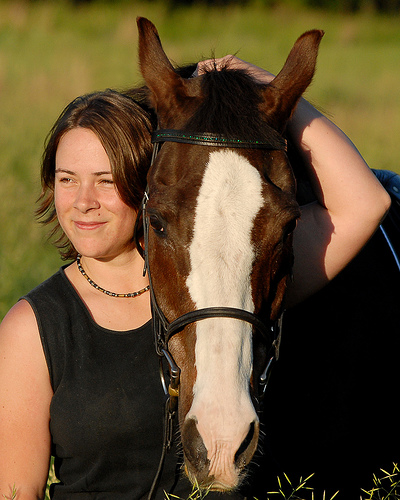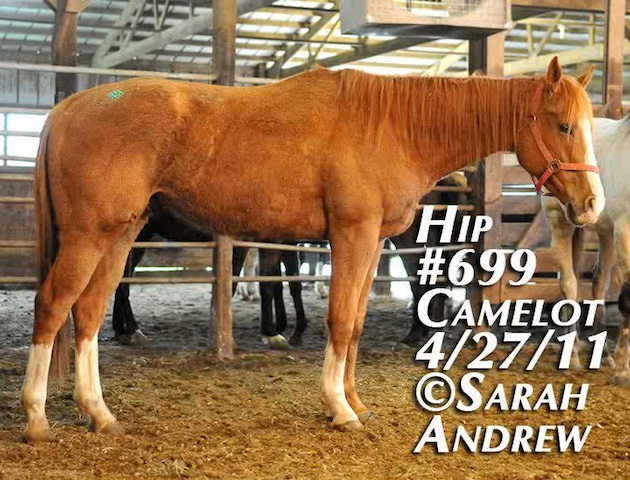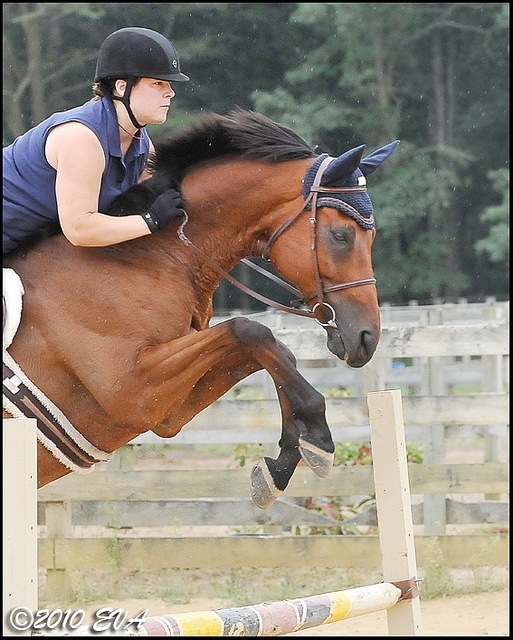Author’s note: This story was originally published in June 2012.
Before she enters the presence of a horse at the Camelot auction house, photographer Sarah K. Andrew approaches with the same respect she would show a world-class Olympic Sporthorse, or a winning racehorse.
To her, the meekest creatures who wind up at auction, and possibly the slaughter pipeline, are just as noble as the loftiest competitors; and, if by taking their picture, she can help tell their story, and change their fates, her volunteer photography will have paid off.
In this week’s Clubhouse Q&A, the professional photographer who has volunteered to take the pictures of over 3,000, so far, and author of popular blog Rock and Racehorses, talks about her life photographing horses.
Q: Sarah, you’ve got a deep background photographing horses. How did you get started in this line of work? Did you study photography in school?
Throughout my childhood and teen years, I rode as much as possible, and when I was not in the saddle, I painted, drew, and wrote about horses. Although I studied the equine form at every opportunity and drove my literature and history professors crazy with countless horse-themed papers, I did not pursue a formal degree in art or photography.
I got serious about photography in 2006, when I bought my first SLR camera. I am a self-taught photographer, and I learn by reading everything I can get my hands on and spending countless hours experimenting with the camera.
Once I had a grasp on the basic technical aspects of shooting, I sought out every opportunity I could find, from working for a track photographer, to corresponding with my heroes in the industry, to submitting my work to magazines and newspapers. With every picture I take, I strive to create my own unique artistic voice and vision. My hard work paid off: I work for the Thoroughbred Daily News, I’ve photographed top-level equine athletes from Olympic competitors to Kentucky Derby winners, and my photos are seen worldwide in dozens of books and publications.
Q: When did you start taking pictures of Camelot horses? And, how did that assignment come about?
In January 2010, I joined the team of Camelot volunteers. Their dedication and positive attitude is a huge inspiration to me. The effort officially began in November 2009, but Lisa Post of Helping Hearts Equine Rescue (HHER) was networking these horses on her own before then. Every Wednesday night, Lisa and a few other HHER volunteers attended the horse sale and cataloged and photographed the horses who were sold to the feedlot and were at risk for being shipped to slaughter.
Once I learned about the volunteer effort, I decided that I wanted to help them, and I contacted Lisa to see if I could photograph the horses on Thursdays after the weekly auction. She thought it was a great idea, as long as it was okay with the proprietors of the auction. I called the auction, got their permission, and in 2 ½ years’ time, I’ve photographed close to 3,000 horses at Camelot. It’s very hard work, it takes a lot of time, and it’s very demanding on my equipment, but it’s well worth the effort.
Ida Howell takes the photos on Wednesday nights, and putting an equine face to the descriptions is a huge help for the network of people who were trying to find homes for these horses. Photographing horses at night in an auction house is a difficult endeavor, and Ida deserves a lot of credit for the hard work she does every Wednesday. There are many people who work hard to keep this effort running smoothly, from the Wednesday night note-takers, to the Facebook page administrators, to my mother, Vickie Anderson, who keeps the list of available horses organized while I work on the Thursday photos.
Q: I recently wrote about a horse, who was spotted on the Camelot website, who wound up in a new life in Bermuda because of your portrait of him. His owner specifically credits your pictures as the deciding factor in her decision to take him. Do you hear this type of story a lot? How does it make you feel?
Yes, there are many fantastic stories out there about people who found their perfect horse at Camelot. Some of these people have told me that the horse “spoke” to them through my photos, and that they would never have bought the horses without seeing the photos. I have a lot of admiration for the people who take a chance on these horses and are able to provide a good home for them. It’s hard work for the volunteers who do the weekly cataloging and photography of the feedlot horses, but it’s a lifelong commitment once someone makes that decision to buy a horse.
Q: What are your goals when doing portraits of Camelot horses? And, what is it about your photography that allows their personality to shine through, even from an auction house?
Once I started documenting the auction horses, it became a very important part of my growth as a photographer. I always do my very best to treat these horses with the same dignity and respect that I show world-class racehorses and dressage horses.
Camelot is one of the only auction houses in the country that allows volunteer networking and photography. All of the volunteers work hard to maintain a respectful working relationship with the auction house. I think that because I approached the photography with professionalism, the Camelot proprietors soon understood that I was not there to sensationalize the situation.
Every week, the sale barn is full of new stories. There are retired workhorses, earnest yearlings, honest school horses, and just about every breed, color, and level of training that you can imagine. I take it as a challenge to tell these horses’ stories through my photos. The photos have had such an impact on people that I was asked to create a calendar of the “best of” my auction photos. I teamed up with Gina Keesling of HoofPrints, and we created a 2012 calendar called Horses & Hope: My Year at the Auction.
All proceeds from the sale of these calendars are donated to One Horse At A Time (OHAAT), a 501(c)3 charity dedicated to helping horses in need. The calendar proved to be far more popular than we ever could have expected. We kept selling out of calendars and ended up doing a third print run! To date, we have raised almost $40,000 for OHAAT.
Here’s a link to order the calendar and read some of the press about the project:http://www.hoofprints.com/organizers.html





I follow Camelot on Facebook and love the photographs–each horse does truly speak to you through them. Thank you for doing what you do, Sarah! You and the Camelot volunteer group are angels.
The world is a better place because of people like Sarah…she gives hope to all those horses…
I bought a horse from Camelot last fall (hip #251, 10/10/12), and really credit Sarah for bringing out the best in him. Although it looked as though he had really been through some rough times leading up to his time at Camelot (including going through Sugarcreek, too), Sarah’s photographs of him kept drawing me to him, as well as the descriptions of him from the wonderful Camelot volunteer group. He is now a happy and glowing pasture ornament. Thanks Sarah and Camelot volunteers!
Sarah is the best. Not only does she bring out the beauty that lies within every single horse that she photographs, but her HEART is so good. She truly cares about ALL the horses in the world, not just the high-priced successful ones, but the ones who have wound up in some truly sad places in their lives. Time and time again, the images she takes of the horses of Camelot are what SELLS those horses. Even with all that they have gone through in their lives, Sarah somehow creates a safe space for these horses, and they relax, trust her, and allow their truest selves to be captured by her on film. Sarah’s gift – to the horses and to us – is beyond measure. Thank you for reposting her story, Sue, I can never ever hear it enough!